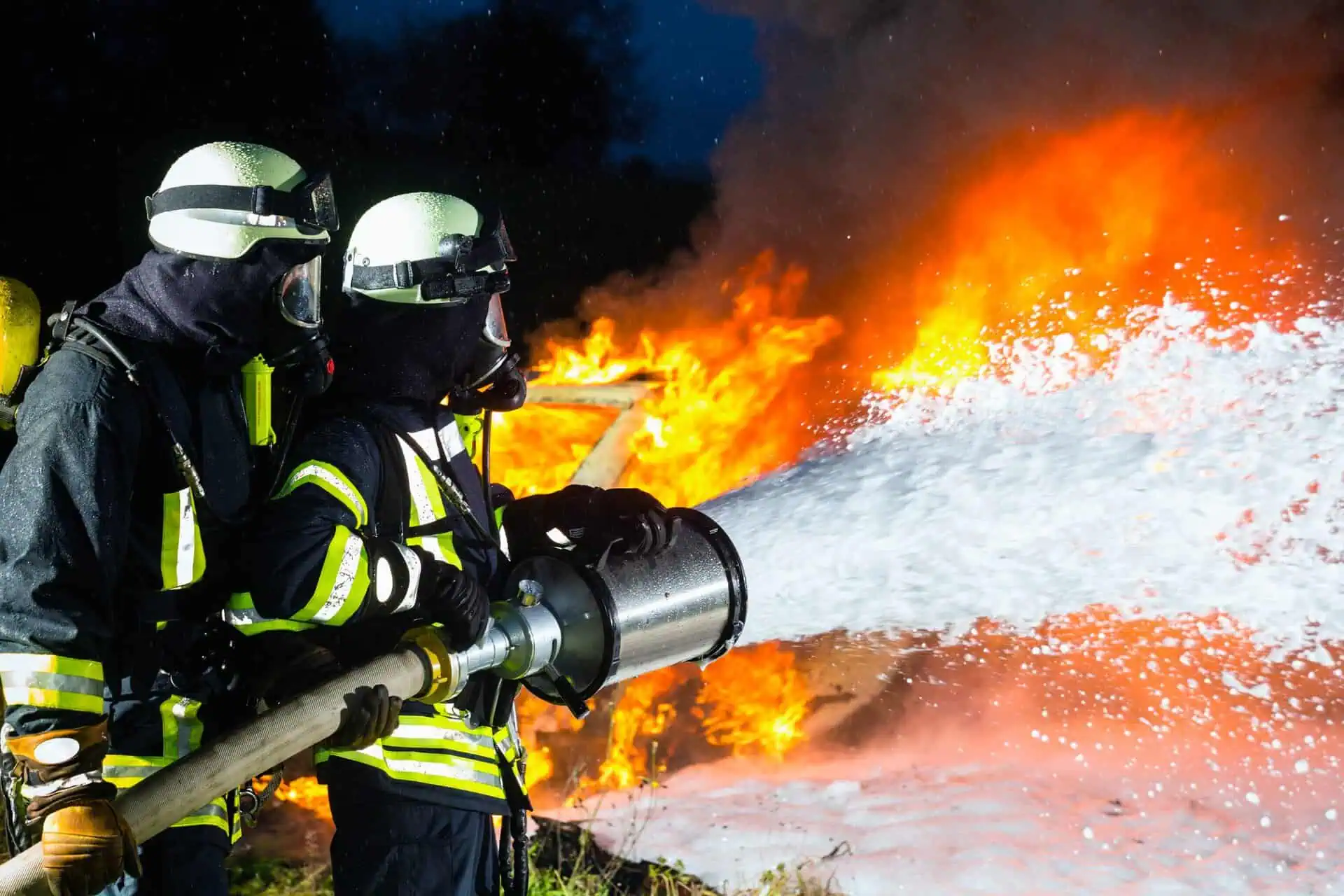AFFF Non-Hodgkin Lymphoma Lawsuit
- Last Updated: June 12th, 2025

Attorney Jessica Paluch-Hoerman, founder of TruLaw, has over 28 years of experience as a personal injury and mass tort attorney, and previously worked as an international tax attorney at Deloitte. Jessie collaborates with attorneys nationwide — enabling her to share reliable, up-to-date legal information with our readers.
Legally Reviewed
This article has been written and reviewed for legal accuracy and clarity by the team of writers and legal experts at TruLaw and is as accurate as possible. This content should not be taken as legal advice from an attorney. If you would like to learn more about our owner and experienced injury lawyer, Jessie Paluch, you can do so here.
Fact-Checked
TruLaw does everything possible to make sure the information in this article is up to date and accurate. If you need specific legal advice about your case, contact us by using the chat on the bottom of this page. This article should not be taken as advice from an attorney.
Key takeaways:
- Firefighting foams like AFFF contain toxic PFAS chemicals that have been linked to cancers such as non-Hodgkin lymphoma.
- Victims, including military and civilian firefighters exposed to AFFF, are filing lawsuits for compensation due to inadequate warnings from manufacturers about health risks.
- Lawsuits aim to cover medical expenses, lost wages, and other damages suffered by those diagnosed with illnesses after using or being exposed to AFFF.
Overview of the AFFF Non-Hodgkin Lymphoma Lawsuit
On this page, we’ll provide an overview of the AFFF Non-Hodgkin Lymphoma Lawsuit , information on average AFFF lawsuit settlement amounts , eligibility criteria to file an AFFF lawsuit , and much more.
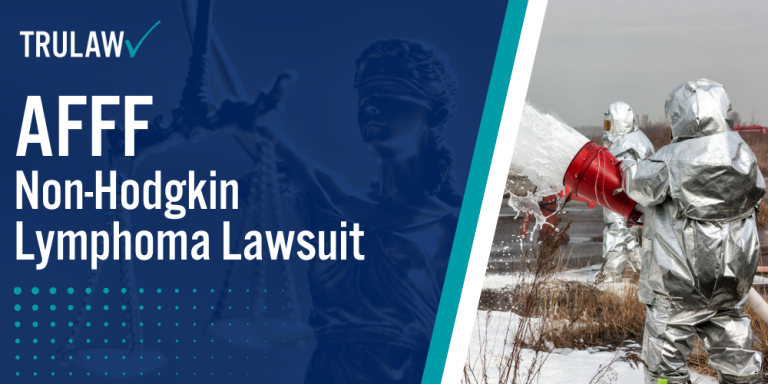
Intro to the AFFF Non-Hodgkin Lymphoma Lawsuits
Aqueous Film Forming Foam (AFFF) has been used since the 1960s to suppress fires fueled by liquids or gases.
This firefighting foam contains PFAS, often referred to as “forever chemicals,” which have been associated with an increased risk of several cancers, including Non-Hodgkin Lymphoma.
Although the use of AFFF has been gradually phased out, many individuals have suffered health effects potentially related to exposure.
If you or a loved one has been diagnosed with Non-Hodgkin Lymphoma, other cancers, or any related health issues due to AFFF exposure, you may be eligible to file an AFFF lawsuit .
Use the chatbot on this page to contact TruLaw and determine if you qualify to file an AFFF lawsuit to date.
Thousands of lawsuits have already been filed by those affected by AFFF, and manufacturers are facing increasing litigation due to health risks associated with PFAS chemicals.
If you believe you’ve been impacted, reach out to us with any questions you may have about your potential AFFF lawsuit .
Table of Contents
Links Between AFFF Firefighting Foam and Non-Hodgkin Lymphoma Risk
The PFAS chemicals present in AFFF firefighting foam have been connected to an array of cancers, including Non-Hodgkin’s Lymphoma.
According to a report by the CDC , prolonged exposure to perfluorooctanoic acid (PFOA), one of the chemicals in AFFF, has been associated with an increased risk of Non-Hodgkin Lymphoma, testicular cancer, and kidney cancer.
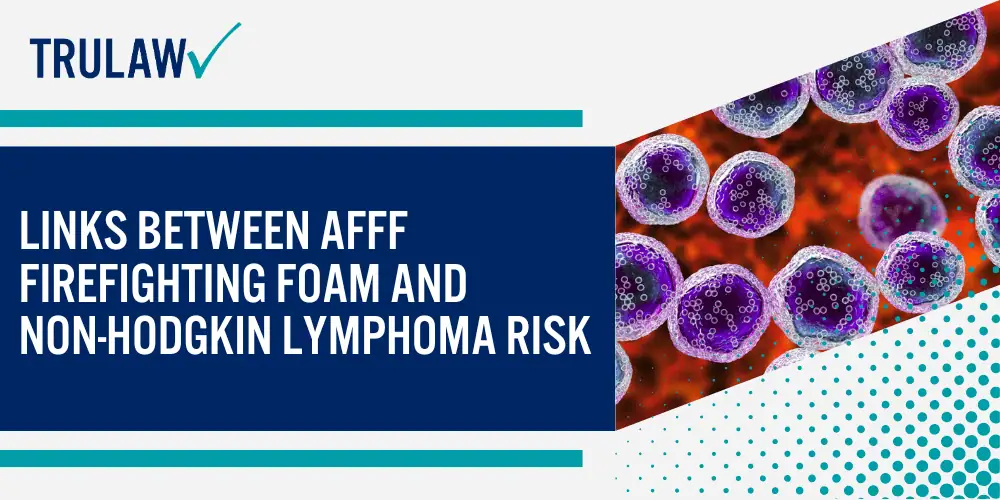
These chemicals belong to a broader category called per- and polyfluoroalkyl substances (PFAS).
The American Cancer Society has identified PFOA as a known carcinogen, which means that individuals exposed to PFAS chemicals face a higher risk of developing cancers like Non-Hodgkin Lymphoma, along with other health complications.
PFAS Chemicals in AFFF Firefighting Foam and Their Impact on Human Health
For decades, the dangers of PFAS chemicals in firefighting foam have been known, and both the US Navy and chemical manufacturers were aware of these risks.
The US Department of Defense eventually issued a warning about the health risks and environmental contamination caused by AFFF.
Multiple studies have connected PFAS chemicals to increased cancer risks and various other health issues.
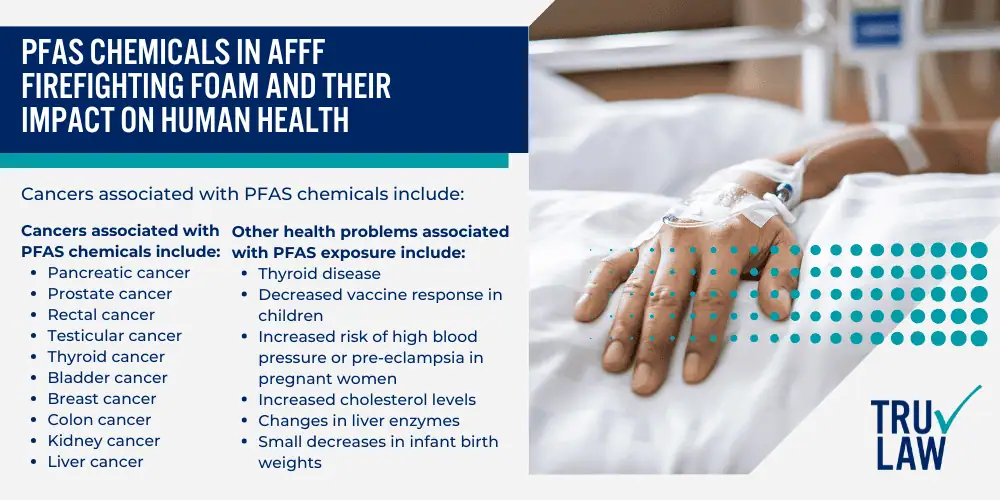
Cancers associated with PFAS chemicals include:
- Pancreatic cancer
- Prostate cancer
- Rectal cancer
- Testicular cancer
- Thyroid cancer
- Bladder cancer
- Breast cancer
- Colon cancer
- Kidney cancer
- Liver cancer
Other health problems associated with PFAS exposure include:
- Thyroid disease
- Decreased vaccine response in children
- Increased risk of high blood pressure or pre-eclampsia in pregnant women
- Increased cholesterol levels
- Changes in liver enzymes
- Small decreases in infant birth weights
Research on PFAS Exposure and Associated Health Risks
As research continues to uncover the extent of the risks posed by PFAS chemicals, the number of lawsuits related to AFFF exposure is expected to grow.
Several studies have examined the link between AFFF exposure and various health problems:
- National Research Center for Environmental Toxicology (Australia): Found higher levels of fluorinated surfactants in the bloodstream of firefighters who had used AFFF.
- University of California, Berkeley: Found that women firefighters exposed to AFFF had higher levels of PFAS in their bodies, further linking the chemicals to cancer risk.
- Journal of the American Medical Association: Found an association between PFOA exposure and kidney cancer, testicular cancer, and ulcerative colitis.
- International Journal of Cancer: Identified a positive association between PFOS exposure and an increased risk of breast cancer.
- International Agency for Research on Cancer (IARC): Classified PFOA as a possible carcinogen and PFOS as potentially carcinogenic to humans.
- US Environmental Protection Agency (EPA): Issued a health advisory for PFOA and PFOS, noting that long-term exposure to these chemicals could harm human health.
If you believe you’ve been affected, we encourage you to reach out to learn more about your options.
It’s important to note that TruLaw is only accepting clients with AFFF personal injury claims — we are not accepting clients for the AFFF municipal water contamination lawsuits.
What is the AFFF Firefighting Foam MDL?
Individuals exposed to per- and polyfluoroalkyl substances (PFAS) present in different forms of aqueous film-forming foam (AFFF) are filing AFFF lawsuits against the manufacturers.
These toxic chemicals have been connected to serious adverse health effects, including various forms of cancer.
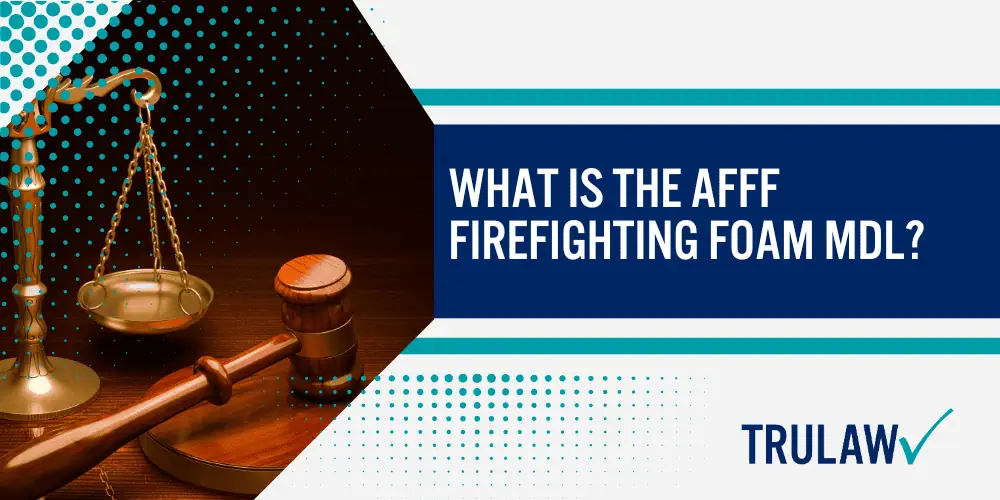
Given the high number of cases, the AFFF firefighting foam lawsuits have been centralized into a multidistrict litigation (MDL) in the US District Court for the District of South Carolina.
This consolidation, known as MDL 2873 , includes lawsuits from individuals across multiple states who have suffered from AFFF-related health issues.
Sometimes you will see this referred to as the AFFF Class Action MDL — this is incorrect.
Class action lawsuits and multidistrict litigations are similar, but very different.
The experienced firefighting foam lawyers at TruLaw and our partner law firms are actively involved in handling AFFF firefighting foam cases and are currently accepting new clients from all fifty (50) states.
Defendants Involved in AFFF Firefighting Foam Lawsuits
The defendants involved in these lawsuits are manufacturers of AFFF, many of which supplied the foam to military bases and other facilities.
These companies are accused of producing and distributing firefighting foams containing harmful PFAS chemicals.
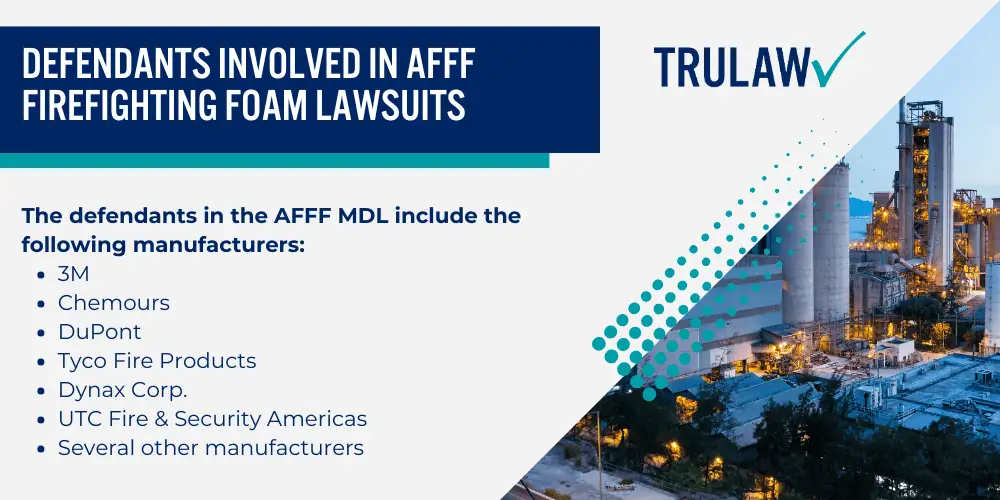
The defendants in the AFFF MDL include the following manufacturers:
- 3M
- Chemours
- DuPont
- Tyco Fire Products
- Dynax Corp.
- UTC Fire & Security Americas
- Several other manufacturers
What are the Average Settlement Amounts for AFFF Lawsuits?
If the lawsuits lead to favorable outcomes, individuals affected by AFFF exposure may receive settlements.
Although no settlements have been reached yet, we can look at similar large-scale civil cases to estimate potential outcomes.
Based on past tort cases, individual settlements in the AFFF MDL could range from $20,000 to $600,000 (or more).
However, the actual settlement amount you may receive will depend on the specific details of your case, such as the level of exposure, the severity of the illness, and other damages you may have experienced.
These estimates are not guarantees, and outcomes will vary based on individual circumstances.
Process for Filing an AFFF Non-Hodgkin Lymphoma Lawsuit
AFFF lawsuits are being filed by individuals diagnosed with cancer, such as Non-Hodgkin Lymphoma, after being exposed to toxic firefighting foam.
If you or a loved one has been diagnosed with Non-Hodgkin Lymphoma or another cancer due to AFFF exposure, you may be eligible to join the ongoing lawsuits.
Contact TruLaw to receive an instant case evaluation by using the chat on this page.
Collecting Evidence for Aqueous Film-Forming Foam Lawsuits
Building a strong AFFF case requires gathering solid evidence to support your claim.
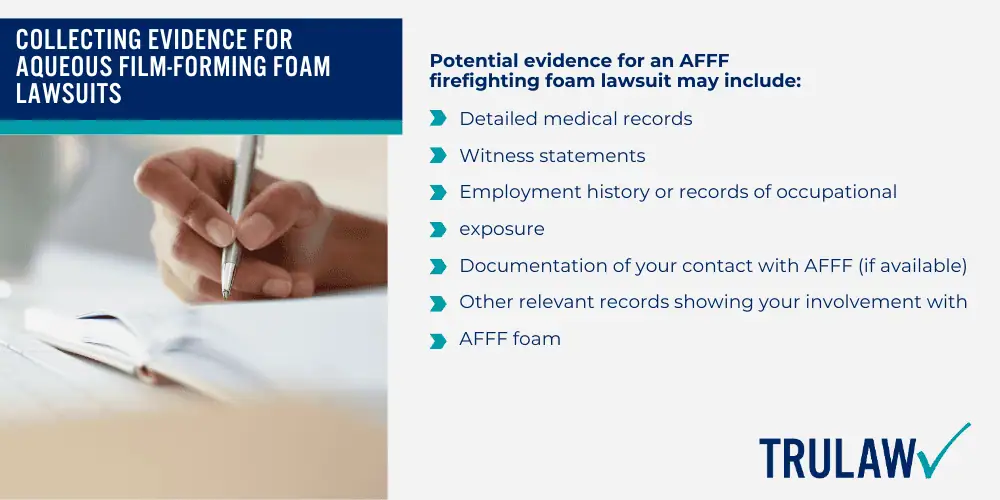
Potential evidence for an AFFF firefighting foam lawsuit may include:
- Detailed medical records
- Witness statements
- Employment history or records of occupational exposure
- Documentation of your contact with AFFF (if available)
- Other relevant records showing your involvement with AFFF foam
Potential Compensation in Firefighting Foam Lawsuits
Damages refer to the losses an individual suffers as a result of PFAS exposure, including both economic and non-economic factors.
In an AFFF lawsuit , the legal team can help determine and calculate the full extent of these damages.
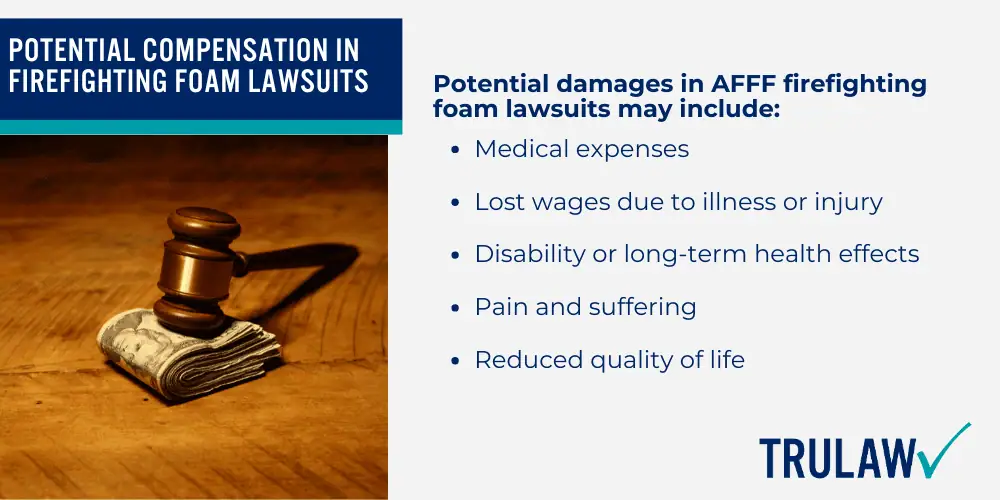
Potential damages in AFFF firefighting foam lawsuits may include:
- Medical expenses
- Lost wages due to illness or injury
- Disability or long-term health effects
- Pain and suffering
- Reduced quality of life
If you’ve lost a loved one due to a PFAS-related illness, such as Non-Hodgkin Lymphoma, you may also be eligible to claim damages through a wrongful death lawsuit.
These claims can seek compensation for loss of companionship, funeral expenses, and other related costs.
The Importance of Selecting the Right Legal Team for Your AFFF Lawsuit
Pursuing legal action against AFFF manufacturers involves both scientific and legal challenges.
To ensure your rights are protected and that you are treated fairly, it is important to work with attorneys who have experience in handling cases of this nature.
From gathering evidence to negotiating potential settlements, we strive to support our clients as they pursue compensation for their health and financial losses caused by AFFF exposure.
TruLaw: Your Firefighting Foam Cancer Law Firm
Exposure to firefighting foam containing PFAS chemicals, whether through incidental contact or occupational use, has been associated with significant health risks.
If you were regularly exposed to firefighting foam and have since developed health issues, you may be eligible to file an AFFF lawsuit .
The firefighting foam lawyers at TruLaw and our partner law firms are dedicated to holding large corporations and firefighting foam manufacturers accountable for the harm caused by AFFF exposure.
Reach out to us today to learn more by using the chatbot on this page to instantly see if you qualify to file an AFFF lawsuit.
AFFF Lawsuit Frequently Asked Questions
-
No, there is currently no AFFF class action lawsuit.
Instead, AFFF lawsuits have been consolidated into a multidistrict litigation (MDL) in the US District Court for the District of South Carolina.
This MDL consolidates individual claims against manufacturers for health issues and damages related to AFFF exposure.
It’s important to note that MDL is distinct from a class action lawsuit.
In an MDL, compensation is awarded based on the unique circumstances of each case, while in a class action lawsuit, compensation is distributed equally among all claimants, regardless of individual factors.
Some law firms may incorrectly refer to the AFFF MDL as an “AFFF Class Action Lawsuit,” but these terms are not interchangeable.
-
Exposure to PFAS chemicals found in firefighting foam has been associated with numerous cancers and other health issues.
Cancers associated with PFAS exposure include:
- Thyroid cancer
- Colon cancer
- Colorectal cancer
- Kidney cancer
- Bladder cancer
- Breast cancer
- Prostate cancer
- Rectal cancer
- Testicular cancer
- Liver cancer
- Pancreatic cancer
Other health problems potentially linked to PFAS exposure include:
- Decreased vaccine response in children
- Increased cholesterol levels
- Changes in liver enzymes
- Small decreases in infant birth weights
- Thyroid disease
- Increased risk of high blood pressure or pre-eclampsia during pregnancy
These risks highlight the dangers associated with long-term exposure to firefighting foam containing PFAS chemicals.
-
No settlements have been reached so far in the AFFF firefighting foam lawsuit.
However, legal experts predict that future settlement amounts may range between $20,000 and $600,000 (or more) per individual .
These figures are based on settlements in other mass tort cases, but they do not guarantee compensation in the AFFF lawsuit.
The actual settlement amount will depend on the details of each individual case and its strength.
-
AFFF Personal Injury Claims involve individuals who have been directly exposed to AFFF (Aqueous Film-Forming Foam) and suffered health consequences.
This often includes firefighters, military personnel, or those living near contaminated sites.
AFFF Municipal Water Contamination Cases focus on the contamination of public water supplies by AFFF.
These cases typically involve municipalities or water providers suing the manufacturers of AFFF for the costs of cleanup and remediation.
It’s important to note that TruLaw is strictly accepting clients with AFFF personal injury claims — we are not accepting clients for AFFF municipal water contamination lawsuits.

Managing Attorney & Owner
With over 25 years of legal experience, Jessica Paluch-Hoerman is an Illinois lawyer, a CPA, and a mother of three. She spent the first decade of her career working as an international tax attorney at Deloitte.
In 2009, Jessie co-founded her own law firm with her husband – which has scaled to over 30 employees since its conception.
In 2016, Jessie founded TruLaw, which allows her to collaborate with attorneys and legal experts across the United States on a daily basis. This hypervaluable network of experts is what enables her to share the most reliable, accurate, and up-to-date legal information with our readers!
Additional AFFF Lawsuit resources on our website:
Here, at TruLaw, we’re committed to helping victims get the justice they deserve.
Alongside our partner law firms, we have successfully collected over $3 Billion in verdicts and settlements on behalf of injured individuals.
Would you like our help?
At TruLaw, we fiercely combat corporations that endanger individuals’ well-being. If you’ve suffered injuries and believe these well-funded entities should be held accountable, we’re here for you.
With TruLaw, you gain access to successful and seasoned lawyers who maximize your chances of success. Our lawyers invest in you—they do not receive a dime until your lawsuit reaches a successful resolution!
AFFF Lawsuit claims are being filed against manufacturers of aqueous film-forming foam (AFFF), commonly used in firefighting.
Claims allege that companies such as 3M, DuPont, and Tyco Fire Products failed to adequately warn users about the potential dangers of AFFF exposure — including increased risks of various cancers and diseases.
Depo Provera Lawsuit claims are being filed by individuals who allege they developed meningioma (a type of brain tumor) after receiving Depo-Provera birth control injections.
A 2024 study found that women using Depo-Provera for at least 1 year are five times more likely to develop meningioma brain tumors compared to those not using the drug.
Suboxone Tooth Decay Lawsuit claims are being filed against Indivior, the manufacturer of Suboxone, a medication used to treat opioid addiction.
Claims allege that Indivior failed to adequately warn users about the potential dangers of severe tooth decay and dental injuries associated with Suboxone’s sublingual film version.
Social Media Harm Lawsuits are being filed against social media companies for allegedly causing mental health issues in children and teens.
Claims allege that companies like Meta, Google, ByteDance, and Snap designed addictive platforms that led to anxiety, depression, and other mental health issues without adequately warning users or parents.
Transvaginal Mesh Lawsuits are being filed against manufacturers of transvaginal mesh products used to treat pelvic organ prolapse (POP) and stress urinary incontinence (SUI).
Claims allege that companies like Ethicon, C.R. Bard, and Boston Scientific failed to adequately warn about potential dangers — including erosion, pain, and infection.
Bair Hugger Warming Blanket Lawsuits involve claims against 3M — alleging their surgical warming blankets caused severe infections and complications (particularly in hip and knee replacement surgeries).
Plaintiffs claim 3M failed to warn about potential risks — despite knowing about increased risk of deep joint infections since 2011.
Baby Formula NEC Lawsuit claims are being filed against manufacturers of cow’s milk-based baby formula products.
Claims allege that companies like Abbott Laboratories (Similac) and Mead Johnson & Company (Enfamil) failed to warn about the increased risk of necrotizing enterocolitis (NEC) in premature infants.
Here, at TruLaw, we’re committed to helping victims get the justice they deserve.
Alongside our partner law firms, we have successfully collected over $3 Billion in verdicts and settlements on behalf of injured individuals.
Would you like our help?
